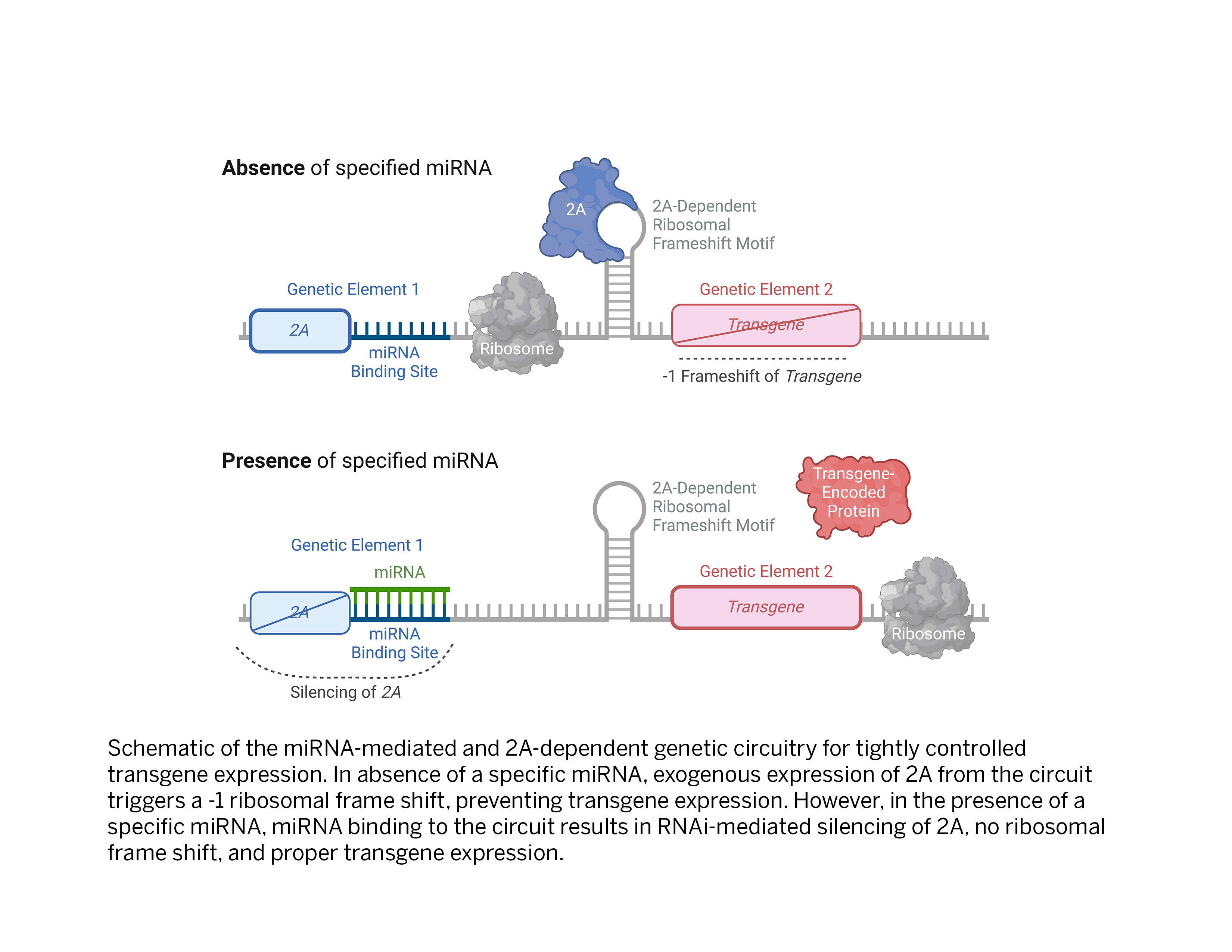miRNA-Mediated Transgene Expression System for Improved Gene Therapies and Research Reagent Applications
A highly specific and tailorable transgene expression systems compatible with conventional gene therapy platforms

Technology
Dr. Benjamin tenOever has developed a novel microRNA-mediated circuit to achieve highly specific and tailorable transgene expression in desired cell types, which can be integrated into conventional virus-based vectors or recombinant mRNA gene therapy platforms. This innovative platform technology exploits (1) protein-dependent ribosomal frameshift biology and (2) the expression specificity of select human microRNAs (miRNAs) in defined cell types. As illustrated in the schematic (see the schematic), the circuit design incorporates two genetic elements, a protein simply called 2A and an RNA element to which it can bind to induce a ribosomal frameshift. The first genetic element is a small RNA binding protein that can be programmably silenced by miRNAs. The second genetic element is the desired transgene (a.k.a., payload or cargo), harboring a frameshift element that only functions in the presence of 2A. In environments where the specific miRNA is absent, 2A from the first genetic element can be translated in the absence of silencing and binds to the ribosomal frameshift motif to alter the reading frame, resulting in an immediate stop codon and loss of transgene expression. However, in the presence of a specified miRNA, the 2A transcript is cleaved and silenced, rendering the ribosomal frameshift element non-functional and thus enabling transgene expression. This thereby permits canonical expression of the desired transgene in a miRNA-dependent context. In unpublished proof-of-concept studies, the tenOever laboratory has demonstrated the capacity of this system to tightly control the production of various reporter genes (e.g., mCherry, Cre recombinase), both in vitro and in vivo, when incorporated into an array of viral-based vectors (e.g., AAV, lentiviral vectors, Sendai virus). In all, this novel platform technology has the potential to revolutionize gene therapies by enabling the treatment or cure of the plethora of currently untreatable or incurable human diseases, especially those hampered by off-target toxicity concerns or highly specific target cell needs.
Background
Gene therapies have shown tremendous success in treating and even curing human disease. However, gene therapy applications are limited by their inability to achieve cell-specific delivery and ideal transgene expression levels. The use of miRNAs to restrict transgene expression to a specific cell-type and minimize off-target effects has shown promise, but existing methods cannot achieve cell-specific expression within the confines of current vector size constraints or using current technologies. Therefore, innovative methods are urgently needed for tightly controlled and customizable transgene delivery systems, such as those regulated by less conventional cell- or tissue-specific markers (e.g., miRNAs). Additionally, there is an unmet need for research reagent tools that enable tunable cell- or tissue-specific delivery of transgenes for in vitro or in vivo applications.
Applications
- Clinical Use: Highly specific and tailorable transgene expression circuit for use in conventional gene therapy platforms, such as:
- Virus-based vectors
- Direct mRNA delivery
- Research Reagent Use: Integration into standard recombinant DNA vectors or viral-based vectors for highly controlled transgene expression in vitro and in vivo
Advantages
- High Specificity: Transgene expression occurs only in the presence of a specific miRNA, such as antigen presenting cells (miR-155), muscle cells (miR-1), specific cell types in the eye (miR-182, miR-96, or miR-183), and/or neurons (miR-124)
- Reduced Off-Target Effects: Cell-specific transgene expression reduces the risk of off-target effects
- Small Genetic Footprint to Maximize Cargo Capacity: The technology described requires less than 500nts to ensure maximum cargo capacity can be maintained
- Tailorable Expression Level: miRNA abundance, 2A stability, and/or the efficiency of the specific ribosomal
Intellectual Property
NYU has filed a U.S. provisional patent application covering the composition and method of use of this genetic circuit
-
expand_more mode_edit Authors (1)Benjamin tenOever, PhD
-
expand_more cloud_download Supporting documents (2)Product brochuremiRNA-Mediated Transgene Expression System for Improved Gene Therapies and Research Reagent Applications.pdfMarketing BriefNYU - miRNA-mediated transgene expression system - Marketing Brief - TEN01-04.pdf (109 KB)